Have you ever been mid swim in the open water when suddenly your throat gets tight, and you find yourself struggling to take a good deep breath? Read on for the reasoning behind this and tips to help manage and prevent these episodes.
Have you ever been mid swim in the open water when suddenly your throat gets tight, and you find yourself struggling to take a good deep breath? Read on for the reasoning behind this and tips to help manage and prevent these episodes.

Professional triathlete, coach and Blueseventy athlete Angela Naeth is no stranger to the open water. With 15 years of racing and coaching under her belt she's seen her fair share of challenges in the open water and assisted many others as they begin their open water swimming journey.
One issue that has plagued her, and many others, is the sudden feeling of a lump in her throat while in the open water, making it nearly impossible to get a breath and increasing anxiety. This lump feeling is formally known as a layrngospasm, an involuntary tightening of the vocal cords that can make breathing feel almost impossible.
Naeth lays out the primary factors that can cause a laryngospasm when swimming, which include:
Any combination of these factors can lead to that lump in your throat, struggling to catch a breath feeling which can further into panic in the open water.
There are several important techniques you can employ to limit or more easily recover from an episode which Naeth outlines in her recent post. The key technique to assist a swimmer in managing these episodes is to focus on breathing.

Below are Naeth's primary breathing techniques that will help alleviate and prevent a laryngospasm attack.
Acclimate to Cold Water Gradually: Don't dive right into freezing water. Get your body used to it first with short swims, cold showers, or even gradually dipping your face into cold water to prevent shock.
Take Breaks: If you start feeling that tightness or difficulty breathing during a swim, slow down, float on your back, and focus on your breathing. This helps you reset and regain control without panicking.
Wear a Wetsuit: A snug wetsuit keeps your body warm, helping prevent cold-induced spasms. It also provides a sense of security and comfort that can reduce anxiety.
Stay Relaxed in the Water: When you feel the tightness starting, focus on staying calm. Remind yourself to exhale fully underwater, keeping your breath steady and smooth.
With time and practice, even those pre-disposed to anxiety and breathing attacks in the water can hone their skills and be able to become a calmer, more confident open water swimmer. Like all things that are worth doing, it takes practice and consistency to overcome these episodes.
For more details on how to practice the breathing techniques outlined above, visit Naeth's coaching blog for the full article.